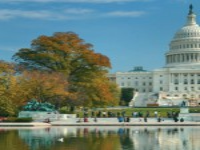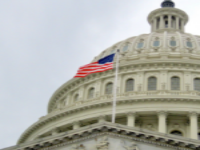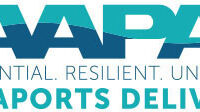AAPA’s 2024 U.S. Legislative Agenda: Empowering Prosperity
As a tidal wave of federal policy and legislation competes for attention in the second year of the 118th Congress, AAPA has set a preemptive course to position America’s seaports for success. From advocating robust appropriations for key maritime infrastructure programs and initiating legislation that would unlock vital funding for Customs inspections facilities at U.S. ports, to collaborating on a study with the U.S. Maritime Administration (MARAD) for advancing domestic port equipment manufacturing, AAPA is charting a route for its members to secure the infrastructure funding, regulatory reforms, and environmental protections they need to persevere.

Sustainable Appropriations Aids Infrastructure Modernization
Topping AAPA’s agenda are initiatives for continued infrastructure modernization and the means to pay for it. As AAPA President and CEO Cary Davis aptly attests, “America’s ports are the gateways to the nation’s economy, yet many facilities struggle with aging infrastructure that hinders competitiveness and efficiency.”
The U.S. Committee on the Marine Transportation System (CMTS) states that sustained infrastructure spending creates a progressively more productive economy. After adjusting for inflation, CMTS predicts maritime infrastructure investments nationwide could produce economy-wide returns of between $2 and $3 per every $1 spent by 2045. Additionally, these investments help provide a bulwark of resiliency against catastrophic climate impacts that threaten the supply chain.
The most beneficial maritime undertakings are found in the U.S. Army Corps of Engineers’ Civil Works program, which includes commercial navigation maintenance and improvements which generate $14 in economic returns for every dollar spent. While maintaining and improving federal navigation channels is imperative to America’s global competitiveness, sadly, funding for the Corps’ Civil Works program remains on an annual, project-by-project basis, requiring the Corps to re-baseline project funding each fiscal year. Most projects are also subject to environmental time-of-year restrictions that can disrupt schedules and budgets. AAPA contends that these and other crucial maritime projects need sustainable, multi-year funding, along with a national coastal navigation strategy, to ensure their timely and cost-effective completion.
The bipartisan 2022–2026 Infrastructure Investment and Jobs Act, which AAPA strongly supported, has been a welcome boon, with more than $6.5 billion in grants exclusively for port programs and an additional $27 billion for which ports are eligible. Yet time is running out on this funding. Consequently, AAPA is ramping up advocacy for sustained, multi-year appropriations through platforms like the annual Port Infrastructure Development Program, the biennial Water Resources Development Act, and related investments in the annual National Defense Authorization Act to modernize America’s ports. (See the sidebar on page 12 for more on the NDAA.)
Only through a comprehensive, national development strategy and consistent federal appropriations that foster navigation advancements, terminal upgrades, technological innovations and environmental protections, will America’s ports showcase their full potential.

Navigating the Currents of Policy Reform
Even when highly beneficial maritime infrastructure projects receive requisite federal funding, there’s still the hurdle of complying with a dizzying array of federal permitting rules and regulations that can take years, sometimes decades, to overcome.
Take, for example, the case of the Port of Albany, New York, which in September 2022 had to relinquish $29.5 million in federal funding due to complications related to the challenging permitting process on a $350 million wind turbine tower manufacturing facility it is building on the Hudson River. Port of Albany CEO Richard Hendrick explains that turning back the federal infrastructure grant money was a necessary decision by the project partners to meet an aggressive production timeline and because of a lack of agreement on the categorical exclusion between state and federal permitting agencies.
“You can’t buy back time,” said Hendrick, adding that the absent federal grant money still needs to be sourced elsewhere.
To help federal project sponsors avoid long and costly permitting delays that can doom ventures from the outset, AAPA supports legislation to speed up the National Environmental Policy Act process, including by setting time limits for agencies to complete their reviews. Further, AAPA is advocating for two changes to the federal permitting process that would ease administrative burdens and provide more clarity to project sponsors. First, the $200 million project cost threshold before a project can be reviewed by the Federal Permitting Improvement Steering Council should be lowered. Second is a long-overdue revision of MARAD’s 1985 List of Categorical Exclusions that exempts projects from extended environmental assessments when they have been deemed to have no significant impact on the environment.
Another recent regulatory challenge AAPA achieved is introduction of the CBP SPACE Act. Congressional passage would limit Customs and Border Protection’s (CBP) ability to compel ports to pay for inspections infrastructure and equipment used by CBP to process cargo and passengers through America’s port facilities. According to Congresswoman Laurel Lee (R-FL), who co-led the bill’s introduction in Congress last November, “Recent demands from CBP requesting ports pay for new and expensive equipment are highly concerning. H.R. 6409 would ensure a portion of the Merchandise Processing Fees will be used to fund CBP’s salaries, expenses, and capital costs associated with inspection operations.”
To enable America’s ports to better source advanced ship-to-shore cranes, trucks, and tractors domestically, AAPA is advocating for legislation that includes incentives to manufacture port equipment on U.S. soil. To inform the proposed legislation, AAPA and MARAD jointly announced a survey of port authorities and marine terminal operators to identify national port cargo handling needs over the next five to 10 years. Led by AAPA through a cooperative agreement with MARAD, the Building American Production Capacity for Electric Port Equipment and Other Port Infrastructure Items information collection effort is scheduled for completion this spring, with a final report issued this summer.
Through interviews with ports and U.S. manufacturers, the study will assess the interest and capability of American and foreign manufacturers to produce cargo handling equipment and other relevant port machinery in the United States, that is now only available overseas. The research will also assess the feasibility of a pooled procurement model for sourcing electrically powered port equipment and port items.
“Given the shortage of American manufactured equipment to handle cargo and the industry-led push to electrify operations in response to a changing climate, it is critical that the U.S. build a domestic capacity for manufacturing clean, electrically powered American cargo handling equipment as an alternative to existing, predominantly foreign sources,” MARAD remarked in a statement.
Innovation, Collaboration, Environmental Stewardship Buoy Economy
Environmental innovations, protections and investments are another key focus for AAPA in 2024.
The Inflation Reduction Act of 2022 provided the U.S. Environmental Protection Agency (EPA) with $3 billion over five years to fund zero-emission port equipment and infrastructure, as well as climate and air quality planning at U.S. ports. However, AAPA strongly opposes EPA’s expected determination that nonmaritime “dry ports” are eligible for the funding, asserting the EPA is straying from Congressional intent.
To protect the EPA’s Clean Ports Program from extending grants to non-maritime projects, AAPA recently submitted comments to EPA Administrator Michael Regan urging the agency to reverse course on its decision to make rail and truck intermodal depots eligible for Clean Ports Program grants. “If the EPA allows rail and truck depots to be eligible,” AAPA remarked in its comments, “seaport project funding will be crowded out.”
FY24 NDAA Bill Contains “Wins” For Ports, Maritime
Among bills typically approved early each fiscal year by Congress is the National Defense Authorization Act (NDAA), which authorizes funding levels and provides authorities for the U.S. military and other critical defense priorities. The FY24 NDAA legislation passed on Dec. 14, 2023.
Contained in this year’s bill are several important provisions sought by AAPA. They include a $500 million reauthorization of the Port Infrastructure Development Program (PIDP), important new PIDP amendments and eligibilities, and a $15 million reauthorization of the U.S. Maritime Administration (MARAD)-led Marine Highways Program.
According to AAPA Government Relations Vice President John Bressler, although NDAA activities aren’t guaranteed to be funded at their authorized levels, they generally realize a higher baseline probability of receiving at least some funding compared to non-defense programs. That’s because national security concerns often take precedence in federal budget allocations.
“Due to the funding priority Congress and the Administration usually give NDAA activities, we’re particularly pleased when port and maritime programs we champion are authorized in the annual defense authorization legislation,” said Bressler. “We often stress that port and maritime programs should receive sustainable appropriations to ensure their long-term viability. Having such programs included in the annual NDAA is a big step in that direction.”
Bressler said this year’s $500 million PIDP authorization represents a 135 percent increase over last fiscal year and “is a big win for the industry,” especially given that the U.S. House’s version of the bill included only $230 million for the discretionary infrastructure grants program.
In addition to PIDP’s increased authorization level, this year’s NDAA made permanent a provision updated last year to allow ports with cruise and cargo terminals to spend PIDP grant money on shore power projects. These are low- and zero-emission ventures to power ships at berth with electricity instead of relying on ships’ fossil fuel-burning engines.
Another important NDAA amendment to the PIDP allows grants to be awarded to projects that support seafood-related business, including fish cargo loading and unloading, seafood processing, cold storage, and other related infrastructure.
There are two other favorable PIDP changes in this year’s defense authorization bill. First is a statute adjustment allowing small ports to submit an independent audit to MARAD if they believe they’ve been incorrectly categorized as a large port for the PIDP small port set-aside. Second is a revision to remove cost-effectiveness and cost-benefit ratio evaluation criteria for projects in Alaska, Hawaii, and U.S. Territories. This will allow projects in these regions to better vie for PIDP’s competitive, over-subscribed grants program.
Bressler noted that AAPA also views the $15 million Marine Highways Program reauthorization in the NDAA as a “win” because it prioritizes, maintains, and protects the program’s authorization at last year’s level. Through the Marine Highways Program, MARAD awards grants on a competitive basis to projects that provide a coordinated and capable waterways alternative to congested landside transportation.

A 2022 survey of AAPA members found that U.S. ports are planning $50 billion of emissions reduction projects over the next decade requiring funding. Given this context, AAPA maintains the EPA should show deference to the intent of Congress and not make its own interpretations with so much at stake.
Another priority maritime environmental initiative with which AAPA is collaborating is the MARAD-funded study titled, Future Energy Options for Ships Operating in the Gulf of Mexico and Lower Mississippi River. The study, which assesses the availability and suitability of alternative fuels for vessels plying the lower Mississippi River and Gulf of Mexico, is slated for completion later this year. A related AAPA collaboration is with ABS, a global provider of classification and technical advisory services to the marine and offshore industries. The collaborative Port Decarbonization Study, due for completion in March, analyzes recent, successful maritime industry efforts to develop low- and zero-carbon energy platforms to power their equipment. AAPA’s goal is to aid ports and their business partners to effectively reduce their reliance on petroleum fuels through “lessons-learned” case studies.
Port economic impact and investment surveys have always been among AAPA’s primary advocacy tools to showcase the tremendous role seaports play in supporting the American economy. To that end, AAPA has contracted Ernst & Young to develop national, state-by-state, and congressional district-by-district analyses of U.S. port economic impacts. This new study, due out in March, is expected to pinpoint evidence of port economic contributions throughout the country, as a follow-up to the port economic impacts study performed by Martin and Associates in 2018.
AAPA CEO Davis notes, “There’s a significant and urgent need for more federal investment in enhancing the connections with America’s ports, and we believe this new study will further substantiate the paybacks of those investments.”
As tides of the 118th Congress ebb and flow this year, AAPA stands steadfast, advancing its legislative priorities with a clear vision for the future. Modern infrastructure, updated regulatory rules, environmental stewardship, and unwavering innovation are the lodestars guiding America’s ports towards a prosperous and sustainable future.




